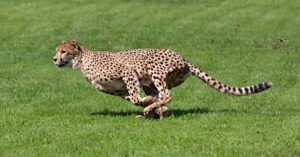Continue reading for our analysis...

Cheetahs remain some of the most fascinating big cats on the planet. Despite this, the worldwide cheetah population continues to dwindle with each passing year. These incredible creatures reach speeds up to 70 mph (miles per hour) and hold the title of fastest land mammal on Earth. Cheetahs live primarily solitary lives aside from females with cubs or males in coalitions. They hunt with extreme precision and enthrall animal lovers with speed and grace.
Threats to Cheetah Populations
Often killed by lions or hyenas, only 5-10% of cheetah cubs survive to adulthood. Furthermore, cheetahs regularly fail at hunting or have their kills stolen by larger, hungry predators. Because they cannot fight anything much larger than a jackal or vulture, cheetahs rather give up their meal and live for another day. Unfortunately, these amazing predators face many challenges in today’s world.
Habitat loss, poaching, human-animal conflict, the illegal wildlife trade, and the cubs’ poor survival rate all contribute to this species’ rapid decline. Thankfully, a few cheetah populations persist in areas of Africa today. Many exist on special game reserves that prevent poaching and allow the cheetahs to live in peace, at least from human conflict. However, these reserves do not keep the cheetahs in, and when they wander outside the borders, they become threatened once more.
Fewer than 50 adults and adolescents live in the Horn of Africa (the northeastern part of Somalia). This is due to the extreme poaching (theft) of young and baby cheetahs that enter into the illegal wildlife/pet trade. Rich people, particularly in Dubai, like to purchase these cubs as pets and train them for hunting and racing. Mainly, owning a cheetah provides these people with a status symbol without regard to the quality of life of the big cat.

Cheetah populations face many threats, both natural and those imposed by humans.
©Stu Porter/Shutterstock.com
How Many Cheetahs Are Left in the World?
The total count of African cheetahs stands at about 7,000 mature adults, according to the 2023 Red List. This list, published by the International Union for Conservation of Nature and Natural Resources (IUCN), keeps track of all known species and their status regarding extinction. This number pales in comparison to years past, and the cheetahs left in the world face major problems with survival.
In 1900, an estimated 100,000 cheetahs roamed the Earth. The current cheetah population is only 0.07% of that number. Some other resources place the number at roughly 10,000. Nevertheless, the worldwide cheetah population has significantly decreased in the last 123 years.
Let’s learn about the 10 African countries where the highest cheetah populations live!
1. Namibia: The Largest Cheetah Population in the World – 3,400
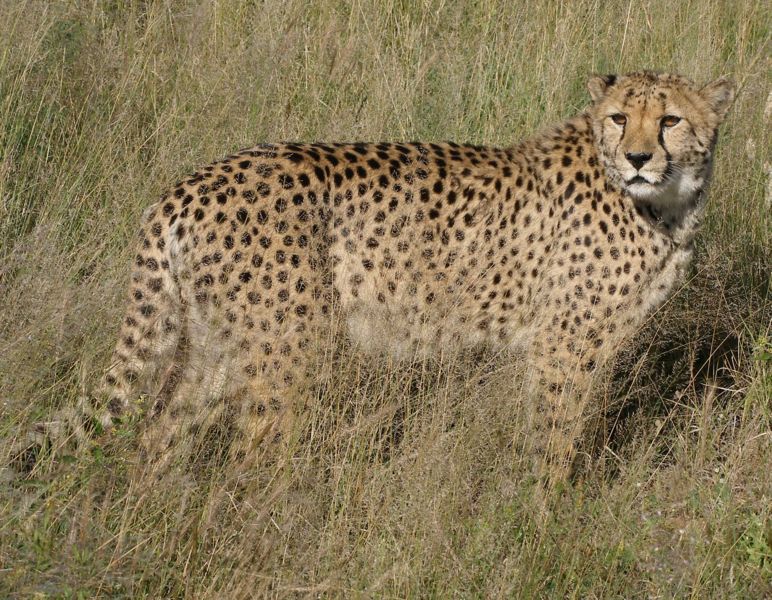
Namibia boasts the largest cheetah population in the world.
©Falense, CC BY-SA 3.0, via Wikimedia Commons – License
The African country with the highest cheetah population is currently Namibia. This country is situated northwest of South Africa, and about 2.53 million people inhabit the area.
Reports estimated roughly 2,500 individuals lived in the area as of 1996, although 90% lived in unprotected areas. Many cheetahs in this area live on or near farmland, where human-animal conflict proves to be a very real and dangerous concern. Cheetahs become the subject of conflict through actual or perceived livestock kills.
Farmers, who have every right to protect their livelihood, shoot and kill any predators who threaten their farm animals. In the 1990s, farmers decimated the cheetah population in Namibia, cutting it in half. During this time, the Cheetah Conservation Fund (CCF) stood up and began their attempts to help both farmers and the cheetahs.
In protected areas of Namibia, the cheetahs face lions and hyenas (also protected) who kill their cubs and steal their meals. Today, the cheetah population in Namibia has recovered a bit, reaching 3,400.
2. Botswana – 1,700
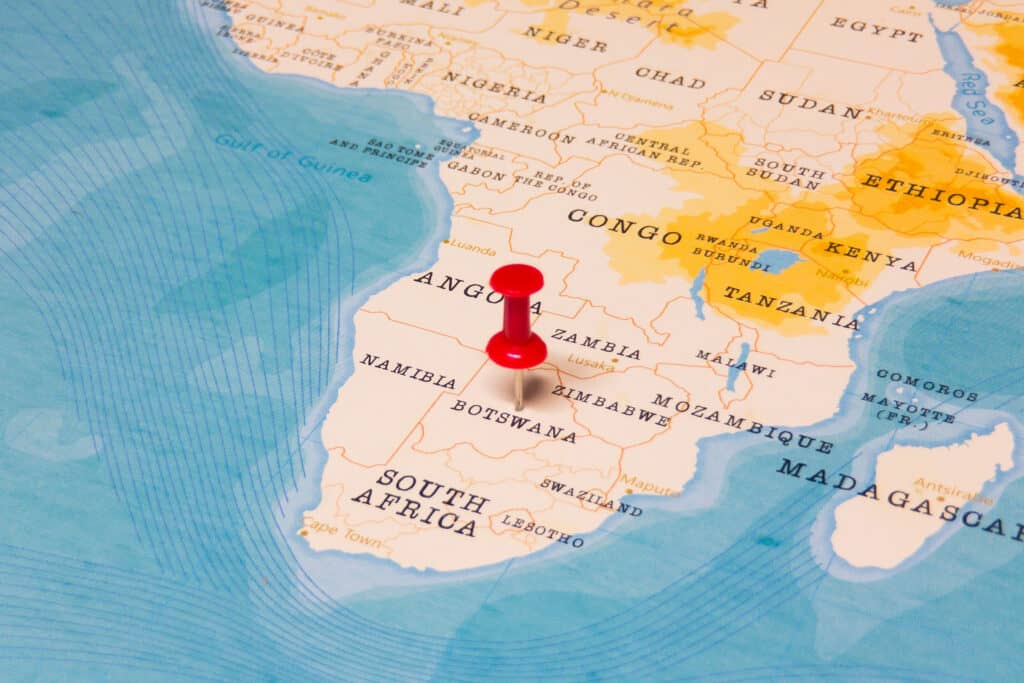
Botswana is directly east of Namibia and north of South Africa.
©hyotographics/Shutterstock.com
Botswana, directly east of Namibia, houses the second-largest cheetah population in Africa. Home to roughly 1,700 of the big cats and more than 2.58 million people, human-animal conflict remains a massive concern. Known for the Kalahari Desert, this land-locked country is difficult to live in.
Fortunately for cheetahs, the Central Kalahari Game Reserve (CKGR) exists in Botswana. This protected area covers more than 20,000 mi² (square miles) of harsh grasslands. Established in 1961, the CKGR is the largest reserve in Africa and the second-largest in the world. Various African animals call the CKGR home but freely travel to and from the area. When not on the reserve, the animals face threats from poachers. Even on the reserve, some poachers still hunt the animals as penalties for poaching do not cause them enough fear to stop.
3. Kenya: Driving Change to Save Cheetah Populations – 1,500
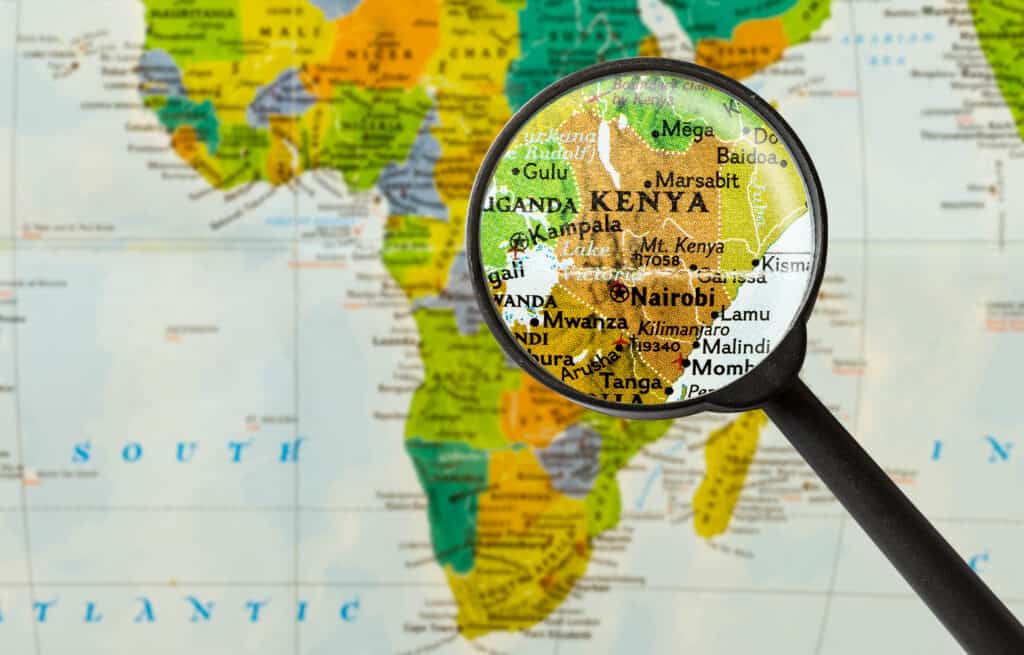
Kenya is one of the most well-known places in Africa.
©iStock.com/naruedom
Kenya, to the southwest of the Horn of Africa, is one of the most well-known places on the continent. Here, humans have come together to protect cheetah populations.
The Action for Cheetahs in Kenya (ACK) organization, established in 2009, promotes healthy relationships between humans and cheetahs. Their mission statement is “to promote the conservation of cheetahs through research, awareness, and community participation in Kenya.” With over 53 million people living there, ACK hopes people will realize the cheetah population needs our help!
They even started a K9 program involving dogs that track cheetah scat (feces or poop). The dogs find the scat, and researchers collect it. The scat is DNA tested to reveal information about what the cheetah is eating and how healthy (or not) it is. This tracking method is non-invasive because the dogs don’t track the cheetah; they only track what they leave behind. Most of the time, the cheetah has left the area before the dog and its handler arrive. This allows researchers to gain significant information without disturbing the cheetah’s natural life. The program also provides a huge information increase without a massive cost increase.
Not only that, but ACK actively participates in local communities to teach them about cheetahs. They discuss how important these big cats are to the ecosystem and how to help them have a future. Kenya is also home to the Masai Mara Nature Preserve, one of the most famous in the world.
4. Tanzania – 1,180
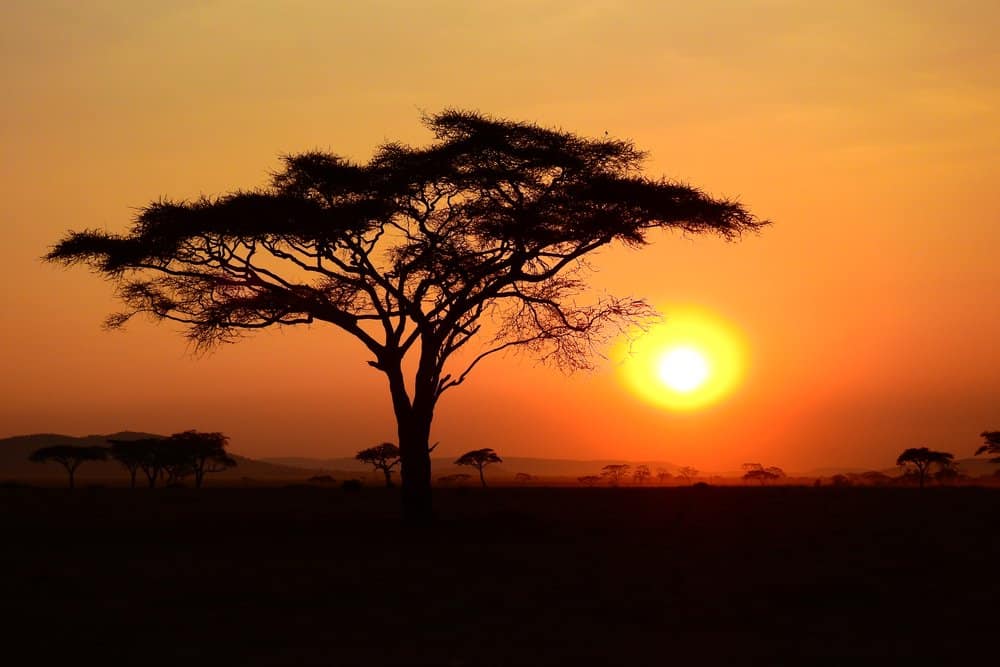
The Serengeti National Park is a protected area in Tanzania for flourishing cheetah populations.
©dktirol/Shutterstock.com
Though cheetah populations present in much lower numbers here than elsewhere, Tanzania remains a great place to see wild cheetahs. The Serengeti and Ngorongoro Conservation Areas offer exciting opportunities to witness them at different camps and on safari. Other national parks in Tanzania include the Lake Manyara and the Ruaha National Parks. Tanzania is also home to 63.5 million people!
The cheetahs native to Tanzania are the largest of the five subspecies, the East African cheetah. The other subspecies include the Northwest African cheetah, the East African cheetah, the South African cheetah, and the Asiatic cheetah. The Asiatic cheetah exists only in Iran, and 12 individuals remain at the end of 2022. Their differences are subtle but enough for scientists to determine them as separate subspecies. The subspecies developed as a result of allopatric speciation. That means species that develop differently due to geographical (location) separation.
5. South Africa – 1,100

South Africa encompasses the entire southern tip of Africa.
©corlaffra/Shutterstock.com
Located at the southern tip of Africa, South Africa has a population of about 1,100 cheetahs and over 59 million people. Several South African cheetah subspecies were transported to India to re-establish the species there. Unfortunately, nine of the 12 cheetahs translocated to the area died as of August 2023. Efforts to continue the project are ongoing.
In South Africa, cheetahs went extinct in the 1870s. Thanks to re-introduction efforts in 2004, the cheetah population has increased significantly. The Samara Karoo Reserve played a huge part in this species’ recovery and continues today’s project. They occasionally swap cheetahs with other reserves to help improve the genetic diversity of the individual populations. This helps to keep the big cats strong and to produce healthy cubs without congenital disabilities.
6. Ethiopia – 500

While a small population of cheetahs live in Ethiopia, they face a great threat from poachers.
©Hyotographics/Shutterstock.com
Hearing the name Ethiopia often brings to mind pictures of starving children. That’s because many of the humans in this country are very poor. Of the 126 million people living there, over 30% live in severe poverty. Without access to clean water and sufficient food, many have turned to the bushmeat trade to feed themselves and make money. This is the illegal killing, eating, and selling of protected animals. Though cheetahs are an unlikely target for bushmeat, their proximity to Somalia and the Horn of Africa also endangers cubs to becoming victims of the illegal pet trade.
One story tells of two 4-month-old cheetah cubs rescued from the palace of the Ethiopian President in 2006. The two cubs were forced to fight one another to get attention for a restaurant. One of the cubs lost an eye to the abuse before a veterinarian rescued the pair. The vet attributed the poor treatment of the animals to the locals’ need for money. They place their interests above the needs of the animals. He also said this is a common occurrence in Ethiopia, where the people view animals as a source of food or money only.
The Cheetah Conservation Initiative aims to stop the illegal pet trade in the Horn of Africa.
7. Mozambique – 478

The Zambezi River provides much-needed water to cheetah populations in the area.
©iStock.com/ANPerryman
Most of the cheetah population in Mozambique lives in the Zambezi River Delta. Here, they have long been the target of poachers. Cabela Family Foundation (CFF) launched a program called 12 Cheetahs in 2021. They released several cheetahs into the Marromeu-Coutada Complex at the end of August that same year. Unfortunately, three of them died. CFF released two additional females in December 2021. In February 2023, they reported two wild cubs were born. CFF publishes annual reports to summarize the movements and news regarding the cheetahs. Each adult wears a tracking collar to help record their movements and activities.
The project, despite its losses, is beginning to succeed! Hopefully, this means that the cheetah population in Mozambique continues to rise.
8. Sudan – 462
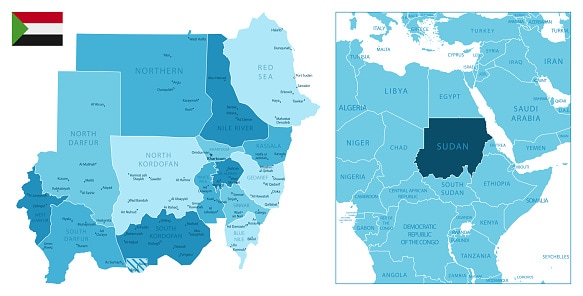
The country of Sudan has been at war off and on for nearly 70 years.
©gt29/ via Getty Images
Situated south of Egypt with a small border at the Red Sea, Sudan is home to a small cheetah population and 45.6 million people. These cheetahs live mostly in the southern part of the country.
Cheetahs have held protected species status in Sudan since 1972. However, rich Sudanese people in northern Sudan provide a huge demand for cheetah skin slippers.
Civil war raged in Sudan between the north and the south between 1955 and 2005. The first civil war lasted from 1955 to 1972. The second they comprised nearly 22 years of fighting (1983-2005), severely affecting wildlife and human life. Not to mention the genocide in Darfur between 2003 and 2020 and the current war between the Sudanese Armed Forces (SAF) and the Rapid Support Forces (RSF). Every living thing in this war-torn land suffers immensely, and the cheetah population is no exception.
9. Chad – 195

Chad’s cheetah population, the people, and the land have all suffered greatly due to war.
©iStock.com/HomoCosmicos
Chad, to the west of Sudan, also experienced an intense civil war between 1960 and 2005. A small cheetah population exists today in the Zakouma National Park.
The country published a National Action Plan in June 2016 for the conservation of both the African wild dog and cheetah populations. Their vision was “A Republic of Chad, with populations of cheetahs and wild dogs protected and restored, managing its biodiversity and natural resources in a sustainable and concerted manner for the well-being of human populations by 2030.”
Within the plan, they set clear goals to learn more about both species, raise awareness regarding their contributions to the ecosystem, and promote peaceful coexistence between all three species (humans, cheetahs, and wild dogs).
They even created a website that listed the action plans for each region of Africa, though it lacked any significant or updated news. Unfortunately, we could not locate any information or updates aside from a newsletter dated March 2016. This newsletter provided no important or direct data regarding the cheetah or wild dog populations. All website and social media links provided led to dead ends.
The only active and related information we found was from the Africa Range-Wide Cheetah Conservation Initiative, which mentions Chad joining them in 2019. The organization’s Facebook does remain active.
10. Zimbabwe – Cheetah Population of Less than 100

Most of the cheetah population in
Zimbabwe
lives in Hwange National Park.
©paulafrench/iStock via Getty Images
Last but certainly not least on our list comes Zimbabwe. The largest cheetah populations in this country exist in the Hwange National Park, the Zambezi Valley, and the Lowveld.
The Cheetah Conservation Project Zimbabwe, founded in 2012, brings together veterinarians and students to help research cheetahs. Together, they spread awareness and educated locals on how to coexist with cheetahs. They also individually identify cheetahs and track them.
Since 2012, they have identified 87 unique cheetahs among the population and added them to a national database. In 2015, the project published a report covering their 2-year-long survey of African cheetahs. They included conservation efforts, a nationwide cheetah survey, cheetah population status, and information on coexistence with cheetahs. They also devoted an entire section to discussing and recommending cheetah conservation across the continent.
The last annual report was published in 2015, and we could not find any current cheetah population counts for Zimbabwe. According to IUCN, less than 100 cheetahs live in Zimbabwe, but they cite the 2015 count, as well.
Summary of the Largest Cheetah Populations in Africa
This table shows the largest cheetah populations in the top 10 African countries where cheetahs live.
| African Region | Cheetah Population Count |
|---|---|
| Namibia | 3,400 |
| Botswana | 1,700 |
| Kenya | 1,500 |
| Tanzania | 1,180 |
| South Africa | 1,000 |
| Ethiopia | 500 |
| Mozambique | 478 |
| South Sudan | 462 |
| Chad | 195 |
| Zimbabwe | <100 |
Final Thoughts on the Cheetah Population
Although the cheetah population worldwide continues to decrease, conservation efforts in several African countries remain strong. Many zoos worldwide also participate in species survival plans and breed captive cheetahs. Other organizations, like Running Wild Cheetah Conservation, breed and raise cheetahs for release into their natural habitat. There is hope yet for the cheetah population!
Thank you for reading! Have some feedback for us? Contact the AZ Animals editorial team.





